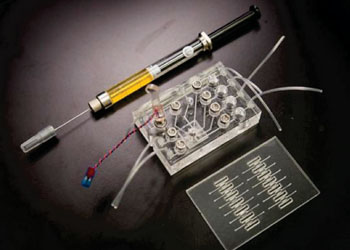Real-Time Mobile Laboratory Developed for Needle Device
By LabMedica International staff writers
Posted on 13 Oct 2015
A truly practical lab-on-a-chip (LOC) system for point-of-care testing (POCT) hepatotoxicity assessment necessitates the embodiment of full-automation, ease-of-use and “sample-in-answer-out” diagnostic capabilities.Posted on 13 Oct 2015
A laboratory in a needle device has been developed that could provide instant results to routine laboratory tests, accelerating treatment and diagnosis by days. This single, self-contained medical device will be effective, for example, in quickly detecting liver toxicity which is a common side effect of chemotherapy. This device will test toxicity in 30 minutes while current liver toxicity tests take several days due to multiple steps required before a physician interprets the test results and communicates them to the patient.

Image: The two key lab in a chip components with a syringe for scale, which will allow for rapid liver toxicity tests (Photo courtesy of Nanyang Technological University).
Scientists at Houston Methodist Research Institute (TX, USA) working with colleagues in Singapore developed an integrated LOC system that is somewhat close to a practical POCT hepatotoxicity assessment device as it embodies both tissue sample preparation and multiplex real-time reverse transcriptase polymerase chain reaction (RT-PCR). It features semi-automation, is relatively easy to use, and has “sample-in-answer-out” capabilities for multiplex gene expression analysis.
The tissue sample preparation module incorporated both a micro-homogenizer and surface-treated paramagnetic microbeads that yielded high-purity messenger ribonucleic (mRNA) extracts— considerably better than manual means of extraction. A primer preloading surface treatment procedure and the single-loading inlet on the multiplex real-time RT-PCR module simplified off-chip handling procedures for ease-of-use. Elevations in the two examined gene markers of liver toxicity were then accurately detected and consistent with previously known changes, indicating that lab in a needle is an appropriate diagnostic option.
Joseph S. Chang, PhD, a professor at Nanyang Technological University (Singapore) and a senior author of the study said, “What we have proven is when the doctor takes a blood or liver sample, the sample can be prepared and analyzed using lab on a chip methods which eliminates the need for wet laboratory work and experts. Our method significantly reduces time, manpower and costs and yet has the same accurate results.” The study was published on September 2, 2105 in the journal Lab on a Chip.
Related Links:
Houston Methodist Research Institute
Nanyang Technological University













